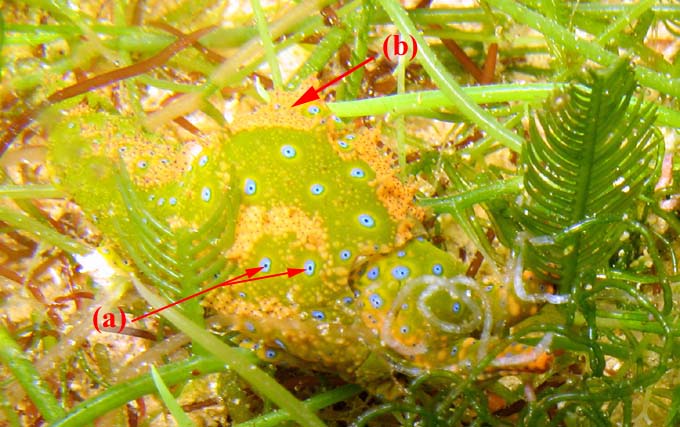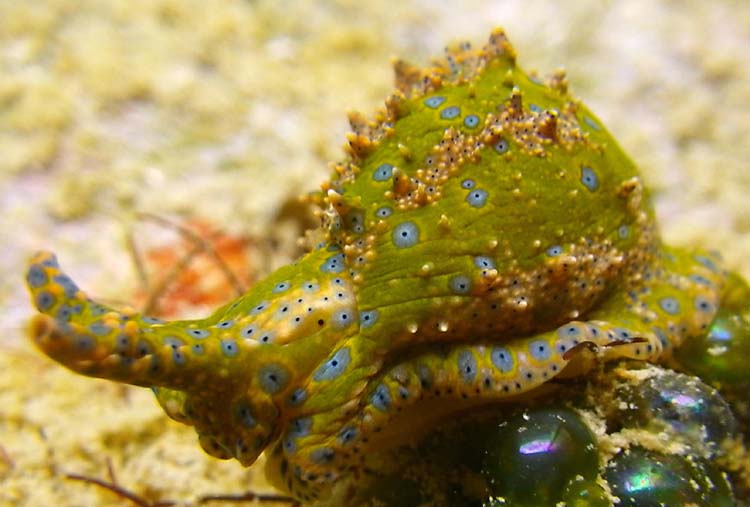This species has been observed on Reunion, Mauritius and Mayotte Islands
The colours varies from bright or pale green to yellowish, with differing concentrations of white to cream pigment along the edges of the parapodia, rhinophores and tail. |

|
|
| Showing species characteristics... | Photo Philibert Bidgrain |
|
See more about : Sightening and mating periods
See more about : Oxynoe viridis variability in Southwest Indian ocean
Remarks :
Identification confirmed by Nathalie Yonow
In Réunion Island we observed a population of O. viridis laying eggs on Caulerpa sertularioides. The Caulerpa identification is confirmed by differents specialists ( B. Cauvin, P. Durville, P. Frouin, J. Mollion)
Synonymous : (according Worms)
- Lophocercus viridis Pease, 1861
Bibliographic data :
It occurs in a wide range of colours and morphology
- some specimens can be muddy live green with white papillae on the parapodial margins and rhinophores
- in some specimens the deep blue spots that can be surrounded by diffuse blue rings
- the blue spots can be range from large blue eye spots all over the body to small blue specks along the parapodial edge
The mouth is ventral, located in a very deep longitudinal slit
The eye are small, located immediately above the lateral grooves which run posteriorly from the inner surface of the folded rhinophores
The penial opening is on a small papilla in the lateral groove on the right side, in front of the eye and under the base of the rhinophore
They can produce a sticky white secretion when attacked or disturbed. There is large glands along the edge of the mantle just at the mouth of the shell. These glands are part of an armoury of "repugnatorial glands'" which produce the white distasteful secretion when the animal is disturbed. Elsewhere on the skin the glands are much smaller
The long muscular tail, which may comprise more than half of the total body length when fully extented, is easely autotomized, and specimen with partly regenerated tails can be observed. As a partial defense the head of the animal can be retracted into the shell, but the elongated tail, failing to be adequately protected by the diminutive shell, so is often autotomized when disturbed
Lays up to 30 000 eggs
It has a fragile white bubble-shaped shell which is partially enclosed by parapodial flaps
Species of Oxynoe are found feeding on a variety of species of Caulerpa : C. racemosa, C. cactoides, C. filiformis, C. cupressoides They are well camouflaged in this algae because of their colour.
References :
Bill Rudman Seaslug site : Sea Slug Forum : Oxynoe viridis
Nudipixel Oxynoe viridis
Publications :
Jensen, K. R. and Wells, F. E. (1990) Sacoglossa (= Ascoglossa) (Mollusca, Opisthobranchia) from southern Western Australia . In: Wells, F.E., Walker, D.I., Kirkman, H. & Lethbridge, R. Proceedings of the Third International Marine Biological Workshop: The Marine Flora and Fauna of Albany, Western Australia. WesternAustralianMuseum, Perth, Vol. 1: 297-331.
Jensen, K.R. (1997) Sacoglossa (Mollusca,Opisthobranchia) from the Houtman Abrolhos Islands and central Western Australia. [In:] The Marine Flora and Fauna of the Houtman Abrolhos Islands, Western Australia . (Ed: Wells, F.E.) Western Australian Museum, Perth, 307-333
Pease, W.H. (1861). Descriptions of new species of Mollusca from the Pacific Islands. Proceedings of the Zoological Society of London : 242-247.
Other photos of Oxynoe viridis :
Maurice Jay Maximal shell size : 11 mm Very light, and open, the upper end of outer lip joins the spire |
 |
 |
Philibert Bidgrain Reunion, Found in a pool at "Kélonia center" a Marine Turtle Center in Saint Leu. 25 March 2009, size : 25-30 (a) The fragile white bubble-shaped shell which is partially enclosed by parapodial flaps A small population was observed during this period.... |
Philibert Bidgrain Reunion, Found in a pool at "Kélonia center" a Marine Turtle Center in Saint Leu. 1 April 2009 O. viridis laying eggs on Caulerpa sertularioides. The Caulerpa identification is confirmed by differents specialists ( B. Cauvin, P. Durville, P. Frouin, J. Mollion) |
Caulerpa sertularioides description : Branches, feather-like, flattened, and upright, 3 - 5 cm high, rising from a creeping stolon (runner), 1 - 2mm in diameter, anchored by rhizoids to the substrate. Branchlets oppositely attached to midrib, flattened, slightly curved upwards and tapered at both base and tip. Midrib is slightly flattened, appearing oval in cross-section. Light green to yellow green. |
 |
 |
(a) The eye : smal, located immediately above the lateral grooves which run posteriorly from the inner surface of the folded rhinophores |
Philibert Bidgrain Reunion, La souris blanche, Trois Bassins, 10 January 2006, size : 8 mm. |
 |
|
Philibert Bidgrain Reunion, Found in a pool at "Kélonia center" a Marine Turtle Center in Saint Leu. 25 March 2009, size : 20-25 mm They can produce a sticky white distasteful secretion when attacked or disturbed. A small population was observed during this period.... |
 |
 |
Alain Barrère Reunion, "Souris blanche" Trois Bassins, on a beach rock, less 1 m, 7 February 2007 It occurs in a wide range of colours and morphology |
Sophie Darnis Reunion, Maharani, Saint Gilles, 10 m, 14 November 2009, size : 10-12 mm  |

A yellowish coloration for this small spécimen It has a fragile white translucent bubble-shaped shell which is partially enclosed by parapodial flaps |
 |
Philibert Bidgrain Reunion, Found in a pool at "Kélonia center" a Marine Turtle Center in Saint Leu. 9 February 2010, size : 30 mm 3 specimens observed... In this specimen the deep blue (a) spots that are surrounded by blue rings all over the body Important concentration of cream pigment (b) along the edges of the parapodia, rhinophores and tail. |
Philibert Bidgrain Mauritius, Le Morne lagoon, less 1 m, 14 March 2011, size : 5 mm A small population found on this Caulerpa sp A pale green form of this species |
 |
 |
Philibert Bidgrain Reunion, Found in a pool at "Kélonia center" a Marine Turtle Center in Saint Leu. 14 April 2010, size : 15 mm |
More photos from Indian Ocean
See more about : Oxynoe viridis variability in Southwest Indian ocean
Reunion, Oxynoe viridis with its spawn, at Saint Leu, by Philibert Bidgrain
Reunion, Oxynoe viridis like Homer Simpson, at Saint Leu, by Philibert Bidgrain
Reunion, O. viridis with large band of cream pigment along the parapodia, at Saint Leu, by Stephane Ciccione
Reunion, important population of Oxynoe viridis, at Saint Leu, by Stephane Ciccione
Reunion, two Oxynoe viridis, at Trois bassins, by Philibert Bidgrain
Reunion, a small Oxynoe viridis with large blue spots, at Trois bassins, by Philibert Bidgrain
Reunion, large population of Oxynoe viridis, at Saint Leu, by Philibert Bidgrain
Mayotte, Oxynoe viridis with numerous blue spots, by Emmanuelle Aigle
Mayotte, Oxynoe viridis with numerous deep blue spots and without tail, by Fabrice Schubert
Reunion, Oxynoe viridis with large papillae, at Saint Leu, by Philibert Bidgrain
Reunion, Oxynoe viridis like a suricate, at Etang salé, by Christophe Cadet